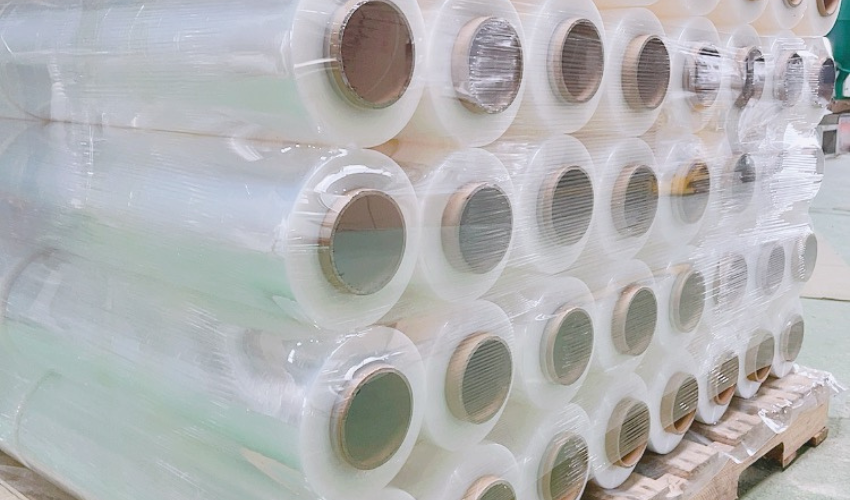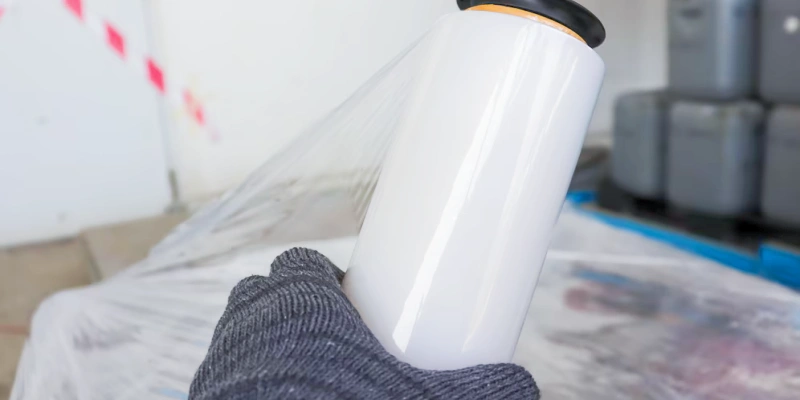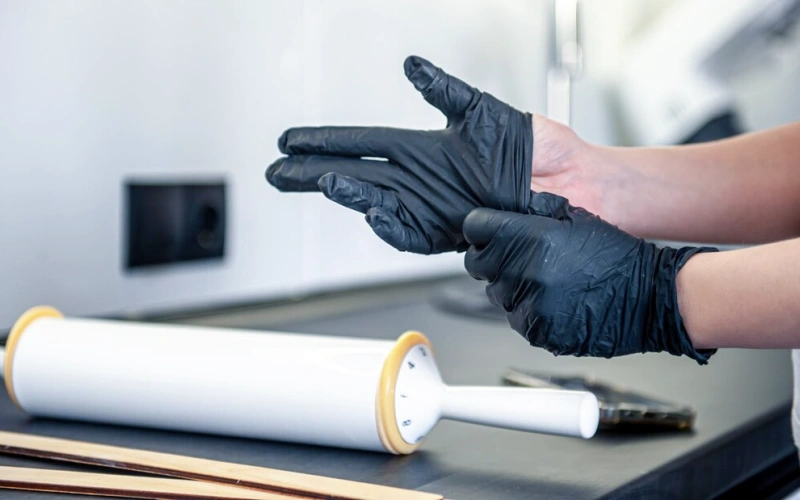
Imagine carefully stacking boxes for shipment, only to discover upon arrival that goods have shifted, collapsed, or been damaged by moisture and debris. For businesses relying on efficient logistics, such scenarios are more than inconveniences—they’re costly setbacks. Traditional packaging methods often fall short: low-quality films tear under tension, leaving loads unstable; uneven tension distribution causes “overwrapped” waste or insecure bundling; and temperature fluctuations weaken adhesion, risking product integrity. These frustrations underscore the need for a smarter solution—hand stretch wrap.
Unlike conventional films, hand stretch wrap leverages advanced polymer technology to deliver unmatched adaptability. Its elastic memory ensures consistent tension, conforming tightly to irregular shapes while resisting loosening during transit. The material’s superior puncture resistance tackles sharp edges and rough handling, minimizing tears that compromise protection. For workers, the ergonomic design reduces hand fatigue, enabling faster, safer palletizing without sacrificing precision. Environmentally conscious brands also benefit: thinner gauges maintain strength while using up to 30% less plastic, aligning with sustainability goals. From securing fragile electronics to stabilizing bulky industrial parts, hand stretch film transforms packaging from a chore into a strategic advantage—slashing costs, reducing waste, and ensuring goods arrive as intended.
By addressing both operational and environmental pain points, this unassuming tool proves that sometimes, the smallest innovations yield the most impactful results.
| Size Parameter | Options | Best For | Key Advantages |
|---|---|---|---|
| Width | 12", 15", 18", 20" | - 12"-15": Small boxes, lightweight items - 18"-20": Large pallets, bulky loads | Wider wraps reduce labor time; narrower widths suit precision wrapping. |
| Thickness (Gauge) | 50–100 microns (1.5–3 mil) | - 50–70μ: Light-to-medium loads - 80–100μ: Heavy-duty, sharp-edged items | Thicker gauges resist punctures; thinner options save material costs. |
| Length | 500–2000 ft per roll | - 500–1000 ft: Occasional use - 1500–2000 ft: High-volume operations | Longer rolls reduce downtime for roll changes. |
| Color | Clear, Black, Blue, Green | - Clear: Inventory visibility - Black/Blue: UV protection for outdoor storage | Colored films enhance security or branding. |
| Core Size | 1.5", 3" | - 1.5": Handheld dispensers - 3": Compatible with mechanical tools | Smaller cores improve portability; larger cores suit automation. |
| Parameter | Imperial Unit | Metric Unit | Conversion Formula | Example |
|---|---|---|---|---|
| Length | Feet (ft) | Meters (m) | 1 ft = 0.3048 m | 1,000 ft = 304.8 m |
| Width | Inches (") | Centimeters (cm) | 1 inch = 2.54 cm | 18" = 45.72 cm |
| Thickness | Mil (1/1000 inch) | Microns (μm) | 1 mil = 25.4 μm | 80 μm ≈ 3.15 mil |
| Roll Weight | Pounds (lbs) | Kilograms (kg) | 1 lb = 0.4536 kg | 20 lbs = 9.07 kg |
| Load Capacity | Pounds per pallet (lbs) | Kilograms (kg) | 1 lb = 0.4536 kg | 1,500 lbs = 680.4 kg |

Hand stretch wrap is a versatile packaging hero, combining advanced engineering with practicality to address everyday logistical challenges. Below, we break down its key performance features and real-world applications—proving why it’s indispensable for industries worldwide.
Scenario: Storing electronics or textiles in humid environments.
Scenario: Transporting mixed-sized boxes on pallets.
Scenario: Relocating delicate antiques or disassembled furniture.
Hand stretch wrap isn’t just a tool—it’s a cost-saving, risk-reducing strategy. Whether battling humidity, stabilizing chaotic loads, or safeguarding heirlooms, its performance adapts to your needs.
Still grappling with scattered goods or damaged inventory? Our hand stretch wrap turns vulnerabilities into victories.
From heavy-duty logistics to eco-conscious packaging, hand stretch wraps come in specialized variations to meet diverse needs. Below, we explore six key types, their unique features, and how they solve real-world challenges
Features:
Why It’s Unique:
Prevents moisture buildup without sacrificing protection—perfect for fresh produce, pharmaceuticals, or electronics stored in humid environments.
Use Case:
A food distributor reduced spoilage rates by 25% after wrapping pallets of leafy greens with vented film, balancing ventilation and containment during refrigeration.
Features:
Why It’s Unique:
Delivers the same load-holding power as thicker films but with a lighter environmental footprint.
Use Case:
An e-commerce giant cut packaging waste by 30% while maintaining shipment integrity during peak season, aligning with its zero-waste initiative.
Features:
Why It’s Unique:
Excels in securing sharp-edged or uneven loads, such as metal parts or construction materials.
Use Case:
A machinery exporter eliminated pallet collapses during overseas shipping by switching to blown film for wrapping steel components with jagged edges.
Features:
Why It’s Unique:
A sustainable alternative for businesses aiming to meet strict eco-certifications or reduce landfill waste.
Use Case:
A organic skincare brand achieved carbon-neutral shipping by pairing biodegradable wrap with compostable pallet boxes, enhancing its eco-luxury branding.
Features:
Why It’s Unique:
Saves space and reduces waste for businesses with irregular packaging needs, like retail stores or workshops.
Use Case:
A furniture repair shop uses mini wraps to bundle disassembled table legs and hardware, ensuring no parts go missing during local deliveries.
Features:
Why It’s Unique:
Enhances security (deterring theft by making tampering obvious) or streamlines inventory sorting.
Use Case:
A warehouse adopted color-coded wraps—blue for fragile items, black for outdoor storage—reducing handling errors by 50% and speeding up dispatch.
Need a Wrap That Fits Your Niche?
Whether you prioritize durability, sustainability, or customization, there’s a hand stretch film engineered to tackle your specific pain points. Wholesale hand stretch film: Still unsure which type suits your operations? Let’s match your challenges to the perfect solution.
The stickiness and durability of hand-stretch film directly affects packaging efficiency. Through laboratory simulation of extreme temperature and humidity environment tests, we found that PWP stretch film still maintains 95% of its viscosity at 40°C (the industry average is only 75%). For a warehouse that handles 500 pieces of goods per day, this means reducing rework time by 30%.
Hand stretch wrap’s reliability stems from precision engineering and advanced production techniques. Below, we demystify the manufacturing process, highlighting how raw materials transform into the durable, flexible film trusted by industries worldwide.
| Aspect | Blown Film | Cast Film |
|---|---|---|
| Thickness | Thicker (80–100μ) | Thinner (50–70μ) |
| Clarity | Slightly hazy | High transparency |
| Durability | Superior puncture resistance | Consistent tensile strength |
| Common Use | Industrial, sharp-edged loads | Retail, lightweight packaging |
The method directly impacts performance:
From polymer science to precision engineering, every step ensures your goods stay protected—no matter the journey.

Pairing hand stretch wrap with a hand-held dispenser revolutionizes packaging operations by combining manual flexibility with mechanical precision. Here’s how to optimize this powerful duo for superior load stability and operational efficiency.
Cost Analysis:
| Method | Film Used Per Pallet |
|---|---|
| Manual | 85-100g |
| Dispenser | 55-70g |
The hand-held dispenser system pays for itself in <90 days through:
✓ 3X faster pallet turnovers
✓ 30% lower consumable costs
✓ 5X ROI from reduced damage claims

A Hand Stretch Wrap Dispenser is a manual hand stretch wrap tool designed to streamline the process of wrapping and securing loads, typically palletized goods, using stretch film. It is widely used in logistics, warehousing, and transportation industries to stabilize cargo, prevent shifting during transit, and protect against dust or moisture. Unlike electric or automated dispensers, this handheld device relies on human operation, making it cost-effective, portable, and ideal for small-to-medium-scale applications.
A hand stretch wrap dispenser optimizes load-securing tasks through ergonomic design, adjustable features, and manual efficiency. It bridges the gap between labor-intensive hand-wrapping and costly automated systems, making it indispensable for businesses prioritizing flexibility and affordability.
Tools Needed: Stretch wrap roll, gloves, utility knife/scissors (optional).
Steps:
Prepare the Pallet:
Ensure the load is stable and evenly stacked. Remove sharp edges that could tear the film.
Anchor the Film:
Hold the stretch wrap roll in one hand. Pull out 6–12 inches of film and press the end firmly against the base of the pallet (use the pallet’s edge or a corner).
Wrap the Base:
Walk around the pallet horizontally, wrapping the film tightly 2–3 times at the bottom to secure the load. Overlap each layer by 50% to prevent slippage.
Spiral Upward:
Gradually move upward in a diagonal pattern, overlapping each layer by 25–50%. Maintain tension by stretching the film slightly (about 50–100% elongation).
Keep the film taut but avoid overstretching, which can cause breaks.
Cover the Top:
Once you reach the top, wrap 2–3 horizontal layers around the upper half of the load. For added security, crisscross the film over the top edges.
Finish and Cut:
After the final layer, press the film against the pallet and tear it using the built-in serrated edge on the stretch wrap core or a utility knife. Tuck the loose end under a previous layer.
Tips:
Rotate the pallet (if possible) for smoother wrapping.
Wear gloves to protect your hands and improve grip.
Tools Needed: Stretch wrap roll, gloves.
Steps:
Secure the Starting Point:
Place the item on a flat surface. Pull out 6 inches of film and press it against one side of the item.
Wrap Horizontally:
Circle the item horizontally, overlapping each layer by 50%. Apply tension by stretching the film slightly as you wrap.
Wrap Vertically:
Rotate the item 90 degrees and repeat the process vertically to reinforce stability.
Cover Edges and Corners:
For irregular shapes, fold the film over sharp edges to prevent tearing. Use extra layers on weak points.
Finish:
Press the end of the film against the item and tear it cleanly. Smooth down the edges.
Tips:
For small items, wrap multiple times to ensure rigidity.
Use a “burrito wrap” for boxes: Fold excess film over the top and bottom edges.
Tools Needed: Stretch wrap roll, gloves.
Steps:
Stabilize the Sacks:
Stack sacks neatly on the pallet, ensuring no overhang. Use slip sheets or cardboard between layers if needed.
Anchor the Film:
Secure the film to the pallet base and wrap 2–3 tight horizontal layers around the bottom sacks.
Wrap Each Layer:
Move upward in a spiral, stretching the film to compress the sacks. Focus on areas where sacks bulge or shift.
For unstable loads, add vertical wraps around the entire stack.
Reinforce the Top:
Wrap the top layer 2–3 times horizontally. For extra security, crisscross the film diagonally over the top.
Cut and Secure:
Tear the film and tuck the end under a previous layer.
Tips:
Use pre-stretched film for heavy sacks to reduce effort.
Avoid wrapping too tightly, which can rupture sacks.
Tools Needed: Stretch wrap roll (manual dispenser optional), gloves.
Steps:
Choose the Right Film:
Select a roll width matching your load (e.g., 12–18 inches for pallets).
Hold the Roll Correctly:
Grip the roll with your dominant hand, allowing it to spin freely. Use your other hand to guide the film.
Apply Tension:
Stretch the film to 50–150% of its original length by pulling firmly as you wrap. More stretch = higher load compression but increased risk of breaks.
Control the Angle:
Tilt the roll slightly downward to keep the film taut and prevent sagging.
Cutting the Film:
Use the roll’s built-in serrated edge or a utility knife. Always cut away from your body.
Safety Tips:
Wear gloves to avoid blisters and improve grip.
Keep your workspace clear to prevent tripping while circling the load.

My name is James Thompson, and I’m the editor of this website dedicated to Stretch Film, Pallet Wrap, and Stretch Wrap products.
My passion for packaging began when I noticed the challenges companies face in securing their products efficiently for transportation and storage. This inspired me to delve deep into the world of stretch films and pallet wraps, exploring the latest technologies and best practices.
I aim to provide valuable insights, practical tips, and up-to-date industry trends to assist you in making informed decisions. Whether you’re a small business owner or part of a large corporation, my goal is to support you in optimizing your operations and ensuring your products reach their destination safely.
Thank you for visiting, and I look forward to accompanying you on your journey toward better packaging solutions.
Comments are closed